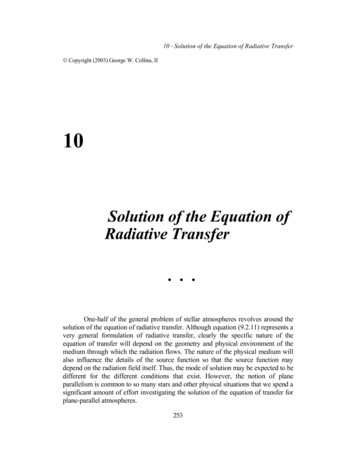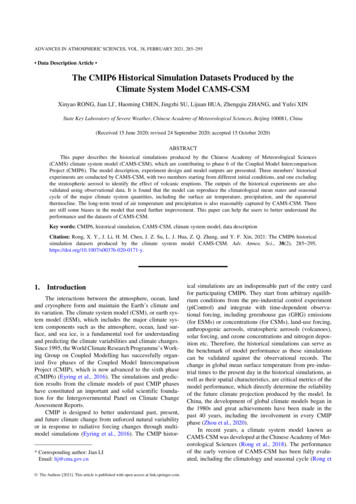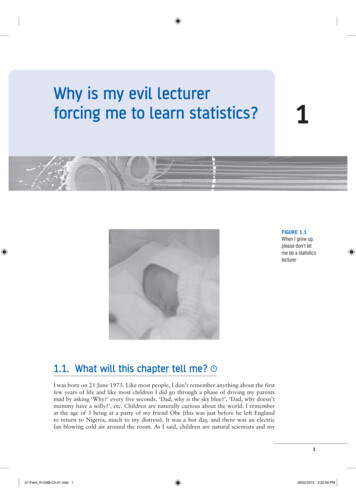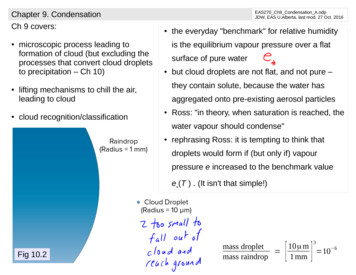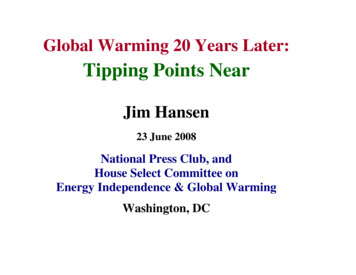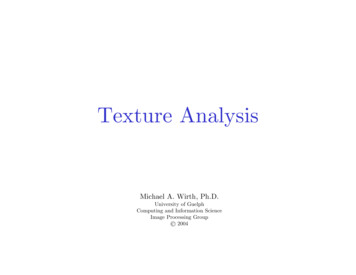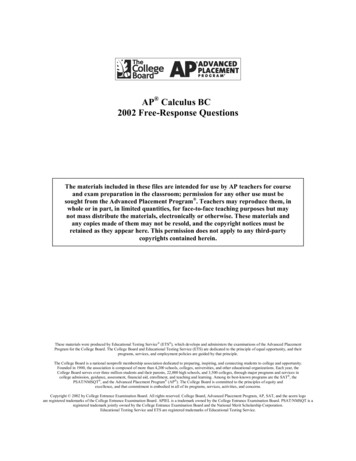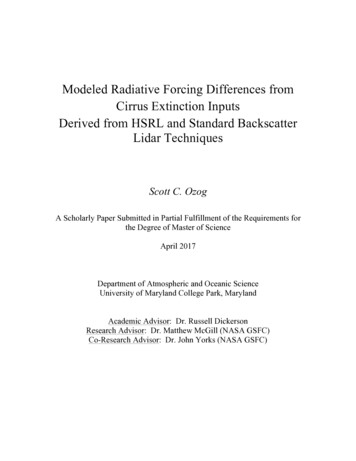
Transcription
Modeled Radiative Forcing Differences fromCirrus Extinction InputsDerived from HSRL and Standard BackscatterLidar TechniquesScott C. OzogA Scholarly Paper Submitted in Partial Fulfillment of the Requirements forthe Degree of Master of ScienceApril 2017Department of Atmospheric and Oceanic ScienceUniversity of Maryland College Park, MarylandAcademic Advisor: Dr. Russell DickersonResearch Advisor: Dr. Matthew McGill (NASA GSFC)Co-Research Advisor: Dr. John Yorks (NASA GSFC)
List of Figures1.Ice Crystal Habits . .82.HSRL total measured spectrum .113.Etalon fringe pattern . .114.a. Etalon channel 1 calibration fit Aug 18th . 134.b. Etalon channel 13 calibration fit Aug 20th . . 135.Etalon channel 1 calibration fit from new calibration technique . .156.a. Mean, standard deviation, and variation of lab defect values . .156.b. Mean, standard deviation, and variation of in-flight defect values. .157.a. Attenuated Particulate Backscatter for March 10th, 2016 .ab data . .167.b. Attenuated Rayleigh Backscatter for March 10th, 2016 lab data .167.c. Attenuated Particulate Backscatter for August 19th, 2016 flight data 167.d. Attenuated Rayleigh Backscatter for August 19th, 2016 flight data .168.Extinction Coefficients for March 10th, 2016 lab data .172
List of MCLWNASANIRSWWMOAirborne Cloud-Aerosol Transport SystemAttenuated Particulate BackscatterAttenuated Rayleigh BackscatterAttenuated Total BackscatterCloud Physics LidarFree Spectral RangeGoddard Space Flight CenterHolographic Optic ElementHigh Spectral Resolution LidarIntertropical Convergence ZoneInfraredMultichannelLongwaveNational Aeronautics and Space AdministrationNear InfraredShortwaveWorld Meteorological Organization3
List of etalon transmission parameterparticulate extinction coefficientmolecular extinction coefficientparticulate backscatter coefficientmolecular backscatter coefficientCalibration Factorwavelengthnanometernumber of photon countsfree spectral range in units of channelssteradianparticulate lidar ratioTwo-way transmissionfree spectral range in units of wavelengthetalon defect parameterrange bin width4
AbstractCirrus are the most common cloud type in the atmosphere (Stubenrauch et al.2013); having a large influence on Earth’s radiative energy balance. The Airborne CloudAerosol Transport System (ACATS) Lidar, used to measure profiles of cirrus optical andspecial properties, has flown onboard the NASA ER-2 high altitude aircraft during threefield campaigns since its first deployment in 2012. ACATS is a high spectral resolutionlidar (HSRL), which has the ability to discriminate between the particulate and molecularcomponents of the lidar return signal. This allows for the direct calculation of opticalproperties, such as particulate extinction and particulate backscatter coefficients, withoutassuming a lidar ratio, which is common with standard backscatter lidars analyses(Fernald et al. 1972 and Klett 1981, 1985). Proper calibration of the ACATS etalon iscrucial in achieving this separation of signal (Mcgill, 1996); however, during ACATS’three field campaigns, automated in-flight calibration of the etalon was not consistentlyreliable due to the speed of the aircraft and the variability of the scene observed. A newcalibration technique has been developed using a scattering medium within the ACATStelescope itself, and is proving to be a viable option for improving in-flight calibration ofthe etalon. Accurate etalon calibration leads to greater confidence in the opticalproperties calculated from ACATS data compared to those calculated from standard lidardata due to the absence of the lidar ratio assumption. This ultimately leads to morerealistic model output, which incorporates these optical properties as input parameters.While HSRL lidars provide more accurate optical properties, they are more expensiveand more difficult to implement than a standard backscatter lidar. Coincident cirrus databetween the NASA ACATS HSRL and the NASA CPL standard backscatter lidar will becollected, from both ground and air platforms, to explore the differences in retrievedoptical properties. I will incorporate these optical properties into the radiative transfer(RT) model, VLIDORT, on the NASA Discover super computer to quantify how alteringcirrus extinction values and microphysical properties influences top of the atmosphere(TOA) radiative forcing.5
1. Introduction1.1 Importance of CirrusCirrus clouds, which are composed of ice particles and found in Earth’s uppertroposphere, and sometimes lower stratosphere (Sassen, 1991; Murphy et al., 1990;Wang et al., 1996), play a crucial role in modulating Earth’s radiative energy budget.Low and mid-level tropospheric clouds, composed of spherical liquid water droplets, areoptically thicker than high cirrus clouds, and block more incoming shortwave (SW) solarradiation; cooling the underlying atmosphere. Cirrus clouds, however, are relativelytransmissive to incident SW radiation while at the same time absorptive to longwave(LW) terrestrial radiation (Stephens 2005). This weak albedo effect combined with arelatively stronger greenhouse effect leads to a generalization that cirrus cause a netpositive TOA radiative forcing (RF) (Liou, 1986); in other words the standard thinking isthat cirrus exacerbate global warming (IPCC, 2013). Globally, cirrus are the mostcommon cloud type, having occurrence frequencies of 40-60% (Mace et al. 2009). In themid-latitudes frequencies are around 30-40%, and in the tropics they can be as high as90% (Wang and Sassen 2002; Martins et al. 2011a). Cirrus clouds also impose possiblepositive climate feedbacks where their effective warming potentially induces furtherwarming. Cirrus downward LW flux is directly related to the surface-cloud temperaturedifference. In a warmer atmosphere cirrus heights are expected to increase leading to agreater surface-cloud temperature contrast, and therefor a greater LW forcing component(Liou, 1986). Although cirrus net RF can be an order of magnitude less than lower liquidwater clouds (Campbell et al. 2016) their occurrence frequencies make them a profoundcontributor to Earth’s climate system. Despite their importance, large uncertaintiesremain with respect to cirrus formation and associated radiative properties. Makingcirrus parameterization a key source of uncertainty in numerical simulations and globalcirculation models (GCM) (Del Genio 2002).Cirrus microphysical properties including particle size, particle shape, numberdensity, and ice water content (IWC) exhibit large variability dependent on the conditionsunder which they form (Sassen, 2001). These microphysical properties determine cirrusoptical properties such as extinction, backscatter, and optical depth, which correspond totheir magnitude of net RF. Taking into account the distribution of microphysicalproperties through the cirrus layer along with layer height and surface albedo, cirrus candisplay a net negative RF instead of exclusively positive (Zhang et al. 1990; Campbell etal. 2016). The temperature, humidity, and formation mechanism in which cirrus developprimarily determine these microphysical properties (Magono and Lee 1966; Pruppacherand Klett, 1997), and separates cirrus clouds into four sub categories; synoptic, injection,mountain-wave, and cold trap (Sassen, 2001). It should be noted that there is a fifthanthropogenic category, contrail cirrus, which will not be discussed. Synoptic cirrusencompass those formed under the influence of large scale synoptic flow that can elevatemoist air, and promote ice crystal nucleation; such as jet stream dynamics, fronts, andRossby Wave interactions. Injection cirrus are the mesoscale counterpart to the synopticcategory, which form in relation to strong convective updrafts and anvil outflow, or blowoff. Globally, injection cirrus are the most common due to the high prevalence ofconvective activity along the intertropical convergence zone (ITCZ) (Nazaryan et al.6
2008). Mountain wave and cold trap cirrus are relatively less common beinggeographically confined to orographic regions and the tropics, respectively. Cold trapcirrus form under cold ( -70 C) high altitude ( 15 km) conditions, which are foundalmost exclusively in the tropics.1.2 Observations of Cirrus PropertiesThere are many instruments available for measuring cirrus optical andmicrophysical properties. Passive remote sensors such as radiometers are used tomeasure the emissivity of cloud layers at specific wavelengths. Liou et al. (1990)demonstrated a technique where the emissivity difference between two channels on thepolar orbiting advanced very-high-resolution radiometer (AVHRR) were used tocalculate cloud optical depth. Sassen and Comstock (2001) used a combination ofground based lidar and radiometer data, known as the LIRAD method (Platt and Dilley1981), to develop a parameterization for cirrus optical depth based in layer thickness andmid-cloud temperature. Passive remote sensing systems are limited by their inability toprovide information on the vertical structure of a layer. These platforms are alsosusceptible to contamination from additional emitting sources either in front of, orbeyond, the intended target layer if not accurately filtered (Meyer and Platnick 2010).In-situ probes flown on aircraft through cirrus clouds provide valuablemeasurements of microphysical properties, and have found significant differencesbetween mid-latitude synoptic cirrus and tropical convective cirrus (Sassen and Benson2001; Wang and Sassen 2002; Lawson et al. 2001, 2006a, 2006b; Yorks et al. 2011a).Lawson et al. (2006a) reported in mid-latitude synoptic cirrus 99% of the total numberconcentration of particles were 50µm. Of those crystals 50µm 50% were made up ofrosette like habits, 40% were irregularly shaped, and the remaining few percent exhibitedcolumn or spheroidal habits. This is in agreement with Lawson et al. (2001), whichfound a high percentage of rosette shaped crystals in mid-latitude cirrus based onobservations using the Cloud Particle Imager (CPI). Examples of ice crystal habitsimaged by CPI are shown in figure 1. Conversely, column and plate habits have beenmore commonly observed in anvil cirrus, while rosettes less frequent. Convective cirrusexhibit a higher concentration of larger particles on the order of 100-400µm, and IWC isalso higher in convective cirrus compared to synoptic (Lawson et al. 2006a, 2010; Noelet al. 2004). It has been found that ice crystal size distributions in cirrus layers are oftenbi-modal, including a small ( 100µm) mode and a larger mode (Mitchell et al. 1996; andKoch 1996). In-situ probes are a key component in collecting direct measurements ofcirrus microphysical properties, however these instruments also have difficulty providingvertical profiles of data and can potentially shatter crystals before measurement (Zhao etal. 2011).The microphysical properties determine cirrus optical properties, and theirassociated radiative properties. Net RF is defined as the difference in net downward SWand net upward LW radiative flux [Wm-2] (Chylek and Wong, 1998), and is estimatedusing numerical radiative transfer (RT) models. The influence on surface temperaturethrough sustained TOA RF is defined as ΔT λ*RF, where λ represents a climatesensitivity parameter (IPCC, 2013). The sensitivity parameter can vary substantiallybetween different forcing agents, the horizontal distribution of RF, and with latitude7
Figure 1: Cirrus ice particle habits imaged by the CPI instrument presented in Lawson et al. 2006a(Forster et al. 2007; Shindell and Faluvegi, 2009). One of most influential opticalproperties is the estimated extinction, or cloud optical depth (COD), which expresses howmuch signal is removed from an incident beam due to absorption and scattering, and is aprimary user input required to run RT simulations. Extinction values used in simulationsare derived from passive or active remote sensing systems. Microphysical properties areoften parameterized in these simulations based on previous in-situ studies. McFarquharet al. (2000) found tropical thin cirrus have a RF as high as 5 Wm-2 with an average of1.58 Wm-2 using lidar derived extinction values, and assumed column crystal habits. Leeet al. (2009) also looked at tropical thin cirrus RF, and found slightly lower values around1.00 0.07 Wm-2 using Moderate Resolution Imaging Spectroradiometer (MODIS)derived optical depths, and varying crystal habit distributions dependent on crystal size.Hong et al. (2016) calculated the zonally averaged cirrus RF over all latitude belts for arange of varying optical depths, and found forcing to be up to 15 Wm-2 in the tropics.The mid-latitudes exhibited a seasonal dependence with values as low as -30 Wm-2 in thesummer, and 10 Wm-2 in the winter. This study used optical depths retrieved fromsatellite radar, CloudSat (Stephens et al. 2002), and lidar, Cloud-Aerosol Lidar andInfrared Pathfinder Satellite Observations (CALIPSO; Winker et al. 2003), and the8
crystal shape was limited to one aggregate habit. Campbell et al. (2016) looked at a yearof daytime mid-latitude zenith pointing lidar data, and found an estimated RF of 0.070.67 Wm-2. This study also identified very thin cirrus (COD 0.01) as having a netnegative RF. Zhang et al. (1999) performed a modeling studying on the sensitivity ofcirrus RF to varying microphysical properties. This study determined that cirrus with abi-model distribution of crystal sizes, common in cirrus clouds, wherein the second modebeing of a large crystal size ( 170 µm), had a net negative RF. A net negative RF wasalso found in cirrus with a large number density ( 107 m-3) of small crystals ( 30 µm).Reducing uncertainty in measurements of cirrus layer microphysical and opticalproperties is a requirement for improving cloud parameterization in GCMs, and is animperative area of climate change research (McFarquhar et al. 2000; Lee et al. 2009;Yorks 2014).Currently, lidar instruments are one of the best tools available for measuringcirrus optical properties. Passive remote sensors such as MODIS are limited by theirinability to obtain the vertical structure of cirrus clouds. In-situ probes like CPI flownthrough cirrus layers provide valuable direct measurements of microphysical properties,however, these instruments are also limited by their inability to provide full verticalprofiles (Zhao et al. 2011). Remote sensing radar systems like CloudSat, which worksimilarly to lidar, often cannot detect thinner cirrus at the longer wavelengths in whichthey operate (Comstock et al. 2002).1.3 Cirrus Profile Retrievals and Lidar TechniquesThe primary method for collecting vertical profiles of cirrus spatial and opticalproperties is through the use of a lidar instrument. There are several different variationsof lidar with the two most common used for measuring cloud-aerosol profiles being astandard backscatter lidar and an HSRL. Both of these lidars measure the elasticbackscatter of emitted laser light from atmospheric molecules and particulates. Lidarsare important because their data provides full atmospheric profiles of spatial and opticalproperties where there is no fully attenuating layer. This data is provided at bothtemporal and spatial resolutions that cannot be met by in-situ instruments, passive remotesensors, or similar radar remote sensors alone.Standard backscatter lidars are currently the most common lidar used forretrieving profiles of clouds and aerosols. These types of lidar are the least complex toimplement, relatively inexpensive, and have been providing reliable ground and air basedmeasurements for decades. For example, the NASA Cloud Physics Lidar (CPL) is astandard backscatter lidar that flies on the NASA ER-2 high altitude aircraft, and hasflown on over two dozen field campaigns since its first deployment in 2000. CPLoperates at 355nm, 532nm, and 1064nm wavelengths, and produces optical properties forits visible and near infrared (NIR) channels (McGill et al. 2002). Standard backscatterand HSRL lidars initially derive atmospheric profiles of attenuated total backscatter(ATB) from their raw photon counts. The ATB is composed of a molecular (Rayleigh)component and a particulate (Mie) component; however, it yields no knowledge of eitherof these components alone. ATB can be written as a function of the backscatter (β) andextinction (α) coefficient optical properties, which also both contain a molecular (βm, αm)and particulate component (βp, αp) (Eq. 1.1). N(r) are the number of photons per range9
β (r) β A (r) β M (r)2ATB N(r)r β (r)T 2 (r, α )CEq. 1.1T 2 (r) exp{ 2 [α A (r) α M (r)]drbin, T2 is the two-way transmission, and C is a calibration factor composed of instrumentparameters. The molecular components of both coefficients can be computed fromprofiles of temperature and humidity provided by either a model or a WorldMeteorological Organization (WMO) upper air radiosonde. Once this is done the twoparticulate components are the only unknowns remaining, but with only one equation.To calculate the particulate components a lidar ratio first must be assumed to reduce thenumber of unknowns down to one (Fernald et al. 1972; Klett 1981). This is the primarychallenge faced calculating optical properties from standard backscatter lidar data. Thelidar ratio used is assumed to be homogeneous throughout a given particulate layer,whether it’s a cirrus cloud, water cloud, or an aerosol layer. Lidar ratios can vary from10 to 100 steradians (sr) depending on the type of cloud or aerosol. The error in thisassumed lidar ratio propagates through to the calculation of the optical properties, andthen further into the output from a radiative transfer model that incorporates the opticalproperties as input. An error in the assumed lidar ratio of just 5 sr can causeapproximately a 20% error in the retrieval of the extinction coefficient (Young et al.2013).The benefit of an HSRL is that a lidar ratio does not have to be assumed whencalculating optical properties. HSRL lidars contain an additional filter within theirreceiver sub-system for differentiating the signal between its molecular and particulatecomponents. This will be referred to as the HSRL technique, and it is made possible bytaking advantage of the difference in spectral broadening that light undergoes whenscattered by air molecules as compared to atmospheric particulates. At visiblewavelengths air molecules will broaden the signal approximately 10-3 nm (Young 1981),and particulates broaden the signal two orders of magnitude less approximately 10-5 nm(Esselborn et al. 2008). Figure 2 depicts an idealized transmission peak from photonsscattered by an atmospheric particulate. The blue curve represents the wide broadeningcaused by the air molecules, while the red curve represents the narrow broadening causedby the particulates. This greater broadening from the air molecules is caused by theirhigh velocities, which are a result of their random thermal motions. Unlike standardbackscatter lidars, which utilize only one channel at each wavelength they operate (unlessthey have depolarization capabilities), HSRLs will use more than one channel for a givenwavelength, those for retrieving the molecular signal and those for the particulate signal.The NASA ACATS HSRL uses an etalon (Fabry Perot Interferometer) as its filter toseparate the lidar signal into its two components. An etalon consists of two paralleloptically flat plates with reflective dielectric coatings on their respective sides facing oneanother. Light that enters the etalon is transmitted through the first plate into the spacebetween the two of them. Here the light undergoes multiple reflections between eachplate where light is either reflected or transmitted. Most light is reflected back out of theetalon with a small percentage transmitted through to the imaging plane. The amount oflight an etalon transmits is a function of the reflectivity of the plates, and the etalon plate10
loss. Light transmitted through the etalon undergoes constructive and destructiveinterference, appearing as a fringe pattern (Figure 3) on the imaging plane. Each whitering represents light that has undergone constructive interference, and has a wavelengthdifferent from the next concentric ring. This difference in wavelength is referred to as thefree spectral range (FSR). The FSR is a function of the original wavelength entering theetalon, plate spacing, and the index of refraction between the plates. The transmittinglaser must be highly stable to stay aligned with the etalon filter, and must maintain thisstability in the environment of the ER-2 aircraft, making ACATS more difficult andexpensive to implement.ACATS has a 24 channel detector array used to retrieve the signal from theinnermost ring of the fringe, and utilizes a holographic optical element (HOE), called thecircle to point converter, that focuses the full circular pattern of the ring onto eachdetector so the entirety of the signal is captured instead of just a small arc. While thereare several methods of making an HSRL lidar, utilizing an etalon to image the fringepattern on to an array of detectors is referred as the multichannel (MC) method (McGilland Spinhirne 1998). The MC method allows ACATS to directly measure bothcomponents of the signal without any assumptions, which HSRL lidars using an iodinefilter must do (Piironen and Eloranta, 1994). The grey shaded region in figure 2represents the detection region that ACATS measures. The molecular signal appears as aflat background signal across all the channels, and the sharp peak represents theparticulate signal. Integrating this flat line of the ACATS spectrum across all channelsyields the molecular component, and then subtracting that from the total signal andintegrating across the remaining peak will yield the particulate component. Simplyintegrating the entire signal across all channels, and then calibrating the signal similarlyto how you would with a standard backscatter lidar would produce the same ATBproduct. However, the HSRL can produce the attenuated Rayleigh backscatter (ARB)and the attenuated particulate backscatter (APB), which make up the ATB. I useweighted least-squares linear fitting method developed by McGill (1996) to retrieve theARB and APB from the raw photon counts.TransmissionTotal HSRL SpectrumWavelengthFigure 2 (left): Transmission spectrum of the Rayleigh (blue) and particulate (red) broadening for atmosphericbackscattered light at 532nm. Figure 3 (right): Etalon fringe pattern caused by the destructive and constructiveinterference of the light between the two reflective plates11
2. Preliminary Research2.1 Etalon CalibrationFor the least-squares fitting routine to accurately retrieve the ARB and APB,defects within the etalon first must be accounted for. Ideally the two plates of the etalonwould have no loss of signal and would be perfectly parallel. However, microscopicdefects on the plates can cause issues of non-parallelism, which decrease the transmissionof the etalon and broaden the transmitted spectrum as well. This is seen across theACATS channels as the peak caused by particulate backscatter being broader and spreadacross more channels than if there were no defects. An etalon calibration procedure foran MC HSRL lidar was developed by McGill et al. (1997a) and operationallyimplemented on ACATS during its field campaigns by Yorks (2014). Software onboardACATS runs a calibration procedure, referred to as an etalon scan, which usespiezoelectric actuators to adjust the gap between the etalon plates. The spacing betweenthe plates on the ACATS etalon is set to 10cm when no etalon scan is taking place, andthe gap is adjusted on the order of picometers during the scan. Adjusting the spacingbetween the etalon plates acts to move the fringe pattern across the 24 channels of thedetector array. During an etalon scan two orders of each channel’s response aremeasured, meaning the peak will move across each channel twice before a scan iscompleted. An etalon calibration value, defect parameter, can then be determined foreach channel by using a least squares fitting technique of the etalon transmission function Δλ n j T (Δλ, j) An cos 2π n sin c ΔλFSR N FSR N FSR n 0Eq. 2.12 1 1 R n 4 π n2Δ2Dλo2An 2 1 R e 1 R 1 R Eq. 2.2Table 2.1. Etalon transmission function variablesVariableAnjnRΔλFSRΔλDescriptionetalon transmission parameterACATS channel numbernumber of iterationsetalon plate reflectivityetalon free spectral rangewavelength offset of initial wavelength and scan wavelength(Eq. 2.1) to the measured response from each channel during the etalon scan. Equation2.2 expands the etalon transmission parameter (An) from the etalon transmission function,and the defect parameter ( 𝑑!! ) is highlighted yellow. Table 2.1 provides a definitionof variables in the transmission function. The correct defect parameter is determinedthrough an iterative process of changing its value in the transmission function todetermine which value yields the best fit to each channel. The process starts at a value of12
zero and is increased by intervals of 1.0 to a maximum of 100. The value that yields thebest reduced chi squared value when fit is determined to be the defect value for thatchannel.2.2 Improved Etalon CalibrationSince 2012 the ACATS instrument has flown in three field campaigns duringwhich etalon scans had been performed mid-flight. Etalon scans performed with zenithpointing lab data cannot be used on aircraft data because the environmental conditions atwhich the etalon operates are different. The temperature and pressure inside theinstrument are different in the lab than compared to flying on board the ER-2 at analtitude of 20km. Thus, etalon scans must be performed during in flight under theconditions that the etalon has been operating, and used to collect data. During these fieldcampaigns defect values retrieved from etalon calibration scans were not consistentlyreliable due to the non-uniformity of the signal from varying backscatter targets and thespeed of the aircraft (200 ms-1). Figures 4a and b show calibration fits from etalon scansperformed during ACATS’ last field campaign in August of 2015. The measured channelresponse is shown in red, and the fitted transmission function is shown in blue. Figure 4ais an example of the response in channel 1 from an etalon scan performed during a flighton August 19th, 2015. This response appears to have a good periodic structure and abroad fit transmission function. However, this example yielded defect values that weretoo high. Figure 4b shows the response in channel 13 from a flight the next day, and isan example of how poor the spectral response can be from in-flight calibration. To havethe most accurate etalon scan possible the signal must be invariant. It was originallydesigned that the stratospheric Rayleigh signal just below the aircraft would be used fora)b)Figure 4a. The calibration fit for ACATS channel 1 from an etalon scan performed on August 19th, 2015 with redrepresenting the spectral response, and blue the transmission function. (b) The calibration fit for channel 13 from ascan performed during a flight the next day on August 20th.calibration, but the molecular signal at this altitude was too weak for viable calibration.A new calibration technique has been successfully tested, and will soon beoperationally implemented, for improving the reliability of etalon scans that areperformed mid-flight. Instead of using the signal backscattered by the atmosphere, it wastheorized, and proven, that a scattering medium inside the ACATS telescope itself placed13
in the path of the laser could be used during calibration instead. This eliminates theaforementioned issue of a variable scene at high speeds resulting in inconsistent etalonscans. Etalon scans performed for zenith pointing ground data are also improved; as theyare susceptible to the same errors from a varying scene. A material that produces thepeak spectral response expected, and also withstands high intensity laser light on theorder of 30 minutes without experiencing any deformation was necessary. It wasdetermined that white Delrin plastic placed in the path of the laser achieved the desiredresults. However, using the delrin alone saturated the detectors so it was also discoveredthat neutral density filters along with a light dispersing element needed to be placed overthe fiber optic tip leading back into the optics box. Figure 5 shows the spectral responsein channel 1 from an etalon scan performed in the lab using this configuration. Theobserved sharp peak and near perfect fit of the transmission function is what’s expectedFigure 5. Spectral response in ACATS channel 1 from a etalon scan performed in the lab using thenew method of white delrin plastic inside the telescope as a scattering mediumin accurate etalon calibration.Once the optimal configuration was determined, testing began to ensure that thismethod was repeatable. To gain knowledge of the reliability of etalon scans from theprevious method, the etalon scans from the seven most recent field campaign flights werecompared to one another. Figure 6b is a plot showing the average defect values across allthe channels from those flights, as well as their standard deviation and coefficient ofvariation. The defect values recovered from the science flights are inconsistent andexhibit variability as high as almost 50% in some channels. For comparison seven etalonscans using the new method were run over the coarse of seven different days. Only onescan was done a day to mimic the conditions ACATS would operat
6 1. Introduction 1.1 Importance of Cirrus Cirrus clouds, which are composed of ice particles and found in Earth's upper troposphere, and sometimes lower stratosphere (Sassen, 1991; Murphy et al., 1990; Wang et al., 1996), play a crucial role in modulating Earth's radiative energy budget. Low and mid-level tropospheric clouds, composed of spherical liquid water droplets, are

